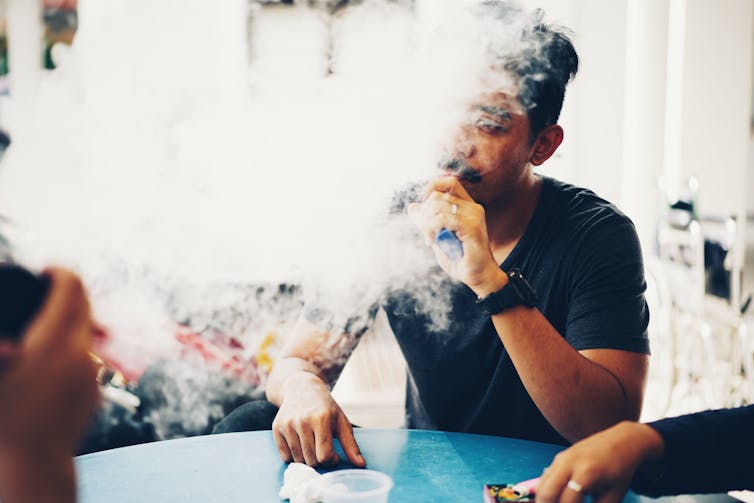Juuling among US youth is about the cool factor, new study suggests
- Written by Tammy Chang, Assistant Professor of Family Medicine, University of Michigan
In less than a decade, e-cigarette use among high schoolers in the U.S. has skyrocketed[1], from almost none in 2011 (1.5%) to more than one-fourth in 2019 (27.5%). Alarm bells[2] have sounded for doctors, parents and schools[3]; lawmakers have created policies to combat this epidemic.
That includes legislation[4] signed by President Trump on Dec. 20, 2019, which raised the minimum age from 18 to 21 on the sale of tobacco products.
E-cigarettes like Juul were covered in the legislation. And even though politics[5] and ambiguity[6] shrouded the move, the U.S. Food and Drug Administration[7] prioritized enforcement against some e-cigarette products that particularly appeal to kids.
Will these efforts work? As an assistant professor[8] of family medicine and researcher at the University of Michigan who specialize in adolescent health, we can tell you what we know[9]: Youth are using e-cigarettes, mostly Juul, in high numbers; most use the flavored kind; and the most popular flavors are fruit, menthol, mint, candy and dessert.
 For teens, the cool factor outweighs the taste factor.
Getty Images/Khaffizzul Hakim Al-Jalil Abdullah/EyeEm[10]
For teens, the cool factor outweighs the taste factor.
Getty Images/Khaffizzul Hakim Al-Jalil Abdullah/EyeEm[10]
It’s not just about taste
We can also tell you what we don’t know: why young people use Juul in the first place. And if we don’t know that, how can we be sure what policies and programs will work?
Because legislative action is about banning flavors, you might think that’s why kids are using Juul – for the taste. However, our recently published research[11], shows something different. Our team surveyed over 1,000 diverse youth, age 14 to 24 years, from all across the U.S. We heard, in their own words, why they think people their age Juul. The answers? Social pressures, the desire to experiment and “the buzz” from the product. Very few (5%) mentioned flavors as a reason for why youth use Juul.
As researchers who work with youth, this made sense to us. After all, they have easy access to candies, snacks, and sodas if they crave something tasty. Why smoke an e-cigarette? True, a Juul with a good taste makes it more fun. But flavor is not the primary driver.
We also found most respondents (79%) believed e-cigarettes were dangerous. They knew Juul had “harmful cancer causing chemicals” and that a single pod “has enough nicotine for 20 cigarettes.” This is opposed to past studies[12] that report most youth didn’t know Juul contained nicotine.
We also asked our participants if they thought using Juul led to use of other substances, like alcohol, cigarettes, or other drugs. 72% believe that it does.
 Young people know more about the dangers of vaping than you might think.
Getty Images / Thomas Barwick[13]
Young people know more about the dangers of vaping than you might think.
Getty Images / Thomas Barwick[13]
Preaching to the choir
Those findings suggest that programs based on warnings of the dangers of Juul may be preaching to the choir. Young people already know, but many still do it to fit in. This insight into the lives of American youth is critical to designing public health messaging and policies that work.
As scientists, we’re not good at making things cool. But what we can do, with help from policymakers, is to use evidence to influence behaviors. And from decades of efforts to curb smoking, we’re aware of two things we can do to decrease e-cigarette use: restriction and enforcement.
The new federal legislation theoretically restricts the purchase of nicotine-laden products. Yet it’s still easy for youth to get Juul[14]. And loopholes[15] in the ban on flavors allow them to keep buying those products.
This means greater efforts in effective enforcement are needed[16]. Without a clear plan, businesses and potential customers around the country will remain confused[17].
Among the best practices[18] for enforcement, say experts[19]: treating violations as a civil, not criminal, offense. Sales to minors shouldn’t involve arrests or police stings, but rather a notice to the owner of the business establishment. Repeated violations would mean larger penalties.
There’s no question that juuling and e-cigarette use is an epidemic among youth. Even if they do it to be cool, there are still things adults can do to protect them. But a law without enforcement effectively means we don’t have a law. In that scenario, the clear winners are adults making money off the sales of these dangerous products. The clear losers are youth.
[You’re smart and curious about the world. So are The Conversation’s authors and editors. You can read us daily by subscribing to our newsletter[20].]
References
- ^ skyrocketed (jamanetwork.com)
- ^ Alarm bells (time.com)
- ^ doctors, parents and schools (www.washingtonpost.com)
- ^ legislation (www.fda.gov)
- ^ politics (www.washingtonpost.com)
- ^ ambiguity (www.nytimes.com)
- ^ U.S. Food and Drug Administration (www.fda.gov)
- ^ As an assistant professor (medicine.umich.edu)
- ^ know (jamanetwork.com)
- ^ Getty Images/Khaffizzul Hakim Al-Jalil Abdullah/EyeEm (www.gettyimages.com)
- ^ research (jamanetwork.com)
- ^ past studies (www.cdc.gov)
- ^ Getty Images / Thomas Barwick (www.gettyimages.com)
- ^ Juul (truthinitiative.org)
- ^ loopholes (www.nytimes.com)
- ^ are needed (www.ketv.com)
- ^ will remain confused (www.mankatofreepress.com)
- ^ best practices (tobacco21.org)
- ^ say experts (tobacco21.org)
- ^ You can read us daily by subscribing to our newsletter (theconversation.com)
Authors: Tammy Chang, Assistant Professor of Family Medicine, University of Michigan


